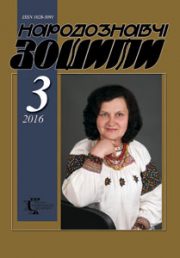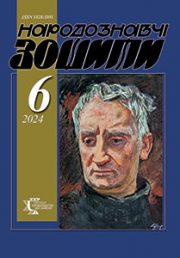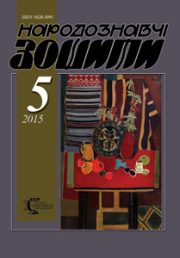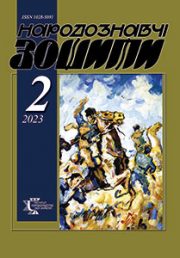The Ethnology Notebooks. 2017, 3 (135), 555–565
UDK 343.264:364.633]055.2(477)
https://doi.org/10.15407/nz2017.03.555
Kis Oksana, candidate of sciences in history,
Senior Researcher at the Institute of Ethnology
of the National Academy of Sciences of Ukraine,
departmeny of social anthropology.
Svobody Avenue 15, 79000, Lviv, Ukraine.
Contacts: e-mail: oksanakis55@gmail.com
Abstract. Tens of thousands of Ukrainian women have been convicted to long¬term imprisonment in the Gulag for political accusations in the mid 20th century. Peculiarities of women’s experiences of confinement were to the great extend determined by specific features of a woman’s body. This theme however is one of the most repressed in women’s narratives from the GULAG. This article is based on the analysis of personal testimonies of former female political prisoners of the GULAG. It discusses what happened to a woman’s body behind the barbed wire and how women tried to preserve their physical health. It shows that a woman’s sexuality could turn into an additional source of survival for some women (taking form of a survival prostitution, quasi¬family alliances etc.). This article also explores the widespread practices of gendered sexual violence against female convicts (forced nudity, body integrity violation, rape etc.).
Keywords: GULAG, political prisoners, Ukrainian women, sexual violence, woman’s body.
Received 21.03.2017
REFERENCES
Adamova-Slyozberh, O. (2002). Put’. Moskva. Vozvraschenye [in Russian].
Andrusiak, Ye. (2001) Spohady. L’viv. LNU im. I. Franka [in Ukrainian].
V namysti z koliuchoho drotu. Spohady zhinok, v’iazniv HULAHu, uchasnyts’ noryl’s’koho povstannia 1953 roku (2009). Uporiad. Kryvuts’kyj I. ta in. L’viv. Manuskrypt [in Ukrainian].
Volovich, Kh. (1989). O proshlom. Dodnes tiagoteet. Vyp. 1: Zapiski vashei sovremennitcy. Sost. S. S. Vilenskii. Moskva. Sovetskii pisatel. S. 478–479 [in Russian].
Herling-Grudzins’kyj, G. (2010). Inshyj svit. Soviets’ki zapysky. Chernivtsi. Knyhy-XXI [in Ukrainian].
Glinka, E. (1990). Trium, ili Bolshoi «kolymskii tramvai»: rasskazsvidetelstvo. Raduga. № 2. S. 14–30 [in Russian].
Grankina, N. (1989) Zapiski vashei sovremennitcy. Dodnes tiagoteet. Vyp. 1: Zapiski vashei sovremennitcy. Sost. S. S. Vilenskii. Biogr. spravka E. Silinoi. Moskva. Sovetskii pisatel. S. 149–174 [in Russian].
Epplbom, E. (2006). Istoriia HULAHu. Per. z anhl. A. Ischenko. Kyiv. Kyievo-Mohylians’ka Akademiia [in Ukrainian].
Zaiachkivs’kaMykhal’chuk, Hanna. (2009). Zaruchnytsia imperii (spohady politv’iaznia). L’viv.PP Soroka [in Ukrainian].
Zemskov, V. (1991). GULAG (istoriko-sotciologicheskii aspekt). Sotciologicheskie issledovaniia. № 6. S. 10–27 [in Russian].
Ivanova, G. (2006). Istoriia GULAGa 1918–1958: Sotcialnoekonomicheskii i politiko-pravovoi aspekty. Moskva. Nauka [in Russian].
Karvans’kaBajliak, A. (2000). Vo im’ia Tvoie (Merezhane zhyttiam) Varshava. Ukrains’kyj Arkhiv [in Ukrainian].
Kis’, O. (2016). Zhinochyj dosvid HULAHu: stan doslidzhen’ ta dzherel’ni resursy v ukrains’komu konteksti. Ukrains’kyj istorychnyj zhurnal. № 3. S. 125–138 [in Ukrainian].
Kokhans’ka, H. (2008). Z Ukrainoiu v sertsi: spohady. Litopys UPA. T. 9. L’viv. Toronto. Litopys UPA [in Ukrainian].
Malsagov, S. A. (1995). Adskie ostrova: Sovetskaia tiurma na Dalnem Severe. Per. s angl. Sh. Iandieva; predisl. V. G. Tankieva ; vstup. st. M. Absametova.Nalchik. Elfa [in Russian].
Meshko, O. (2005). Ne vidstupliusia!: Do 100-richchia Oksany Yakivny Meshko. Kharkivs’ka pravozakhysna hrupa. Uporiad. V. V. Ovsiienko, O. F. Serhiienko. Kharkiv. Prava liudyny [in Ukrainian].
Nepokhytni: Zb. spohadiv (2005). Red. B. Hordasevych. Upor. S. Voloschak. L’viv: Ridna shkola [in Ukrainian].
Neskorena Berehynia: Zhertvy moskovs’ko-komunistychnoho teroru XX stolittia (2002) Svitova federatsiia ukrains’kykh zhinochykh orhanizatsij (SFUZhO). Uporiad. B. O. Hordasevych. Red. H. L. Hordasevych, Yu. Zajtsev. Toronto. L’viv: Piramida [in Ukrainian].
Olitckaia, E. L. (1971) Moi vospominaniia (v 2 kn.) Kn. 2. Frankfurt. Posev [in Russian].
Onyshko, L. V. (2007) «Nam sontse vsmikhalos’ kriz’ rzhavii graty…»: Kateryna Zaryts’ka v ukrains’komu natsional’novyzvol’nomu rusi. Toronto. L’viv. Litopys UPA [in Ukrainian].
Petkevich, T. V. (1993) Zhizn – sapozhok neparnyi: Vospominaniia. Poslesl. B. F. Egorova. Khudozh. I. Arkhipov. Sankt-Peterburg. Astra-Liuks. ATOKSO [in Russian].
Pozniak (Skrypiuk), H. (2001) Meni bulo 19: Avtobiohrafichna rozpovid’. Kyiv. Kyievo-Mohylians’ka Akademiia [in Ukrainian].
Ruzhentceva, T. D. (1996) [Vospominaniia] Vsia nasha zhizn: Vospominaniia Galiny Ivanovny Levinson i rasskazy, zapisannye eiu. Izd. podgot. O. Blinkina, E. Velikanova ; avt. predisl. N. Okhotin. Moskva. Memorial. S. 64–81 [in Russian].
Savka, B. (2003) «A smert’ ikh bezsmertiam zustrila». Narysy spohady dokumenty pro uchast’ zhinotstva tr’okh rajoniv Ternopillia… v natsional’novyzvol’nij borot’bi OUN-UPA. Ternopil’. Dzhura [in Ukrainian].
SlobodianKovaliuk, O. (2010) Za Ukrainu! Za ii voliu! Kolomyia. Vik.
Solzhenitcin, A. (2006) Arkhipelag GULAG. 1918–1956. Opyt khudozhestvennogo issledovaniia. Ch. 3–4. Ekaterinburg : UFaktoriia [in Russian].
Surovtsova, N. (1996) Spohady. Kyiv. Vyd-vo im. Oleny Telihy [in Ukrainian].
Ulanovskaia, N. M. (2003) Istoriia odnoi semi. Sankt-Peterburg. Inapress [in Russian].
Shapovalova, V. (2003) Lager kak obraz zhizni: zhenskie lagernye memuary. Sotcialnaia istoriia. Ezhegodnik. Zhenskaia i gendernaia istoriia. Pod red. N. L. Pushkarevoi. Moskva. ROSSPEN. S. 465–487 [in Russian].
Shapovalova V. (2012) Sestrenki, mamki, damki: tema nasiliia v zhenskikh lagernykh memuarakh. Bytovoe nasilie v istorii rossiiskoi povsednevnosti (XI–XXI vv.). Sankt-Peterburg. EU Sankt-Peterburga. S. 142–163 [in Russian].
Shiriaev, B. N. (1991) Neugasimaia lampada. Moskva. Tvorchestvo russkikh khudozhnikov [in Russian].
Epplbaum, E. (2006) GULAG. Pautina bolshogo terrora. Moskva. Moskovskaia shkola politicheskikh issledovanii [in Russian].
Barnes, S. A.(2011) Death and Redemption: The Gulag and the Shaping of Soviet Society. Princeton University Press.
Chyz, M.(1962) Woman and child in the modern system of slavery – U.S.S.R. Toronto. SUZERO. New York. DOBRUS.
Cormos, G.(2011) Gender Policies in the Romanian Gulag. The Scientific Journal of Humanistic Studies. Vol. 3 (5). Р. 72–73.
Cormos, G.(2009) Women Humiliated in the Romanian Communist Prison. The Scientific Journal of Humanistic Studies. Vol. 1 (1). Р. 72–75.
Gulag Voices: Oral Histories of Soviet Incarceration and Exile (2011) Ed. by Jeanne M. Gheith, Katherine R. Jolluck. New York. Palgrave MacMillan.
Lipper, E. (1951) Eleven Years in Soviet Prison Camps. Chicago. Regnery.
Shapovalov, V. (2001) Remembering the Darkness: Women in Soviet Prisons. New York. Rowman and Littlefield Publishers.
Bondaruk, L. Kenhirs’ke povstannia iak vyiav kryzy systemy HULAH [elektronnyj resurs]. Retrieved from: http://www.memory.gov.ua/news/ do60tilittyakengirskogopovstannyakengirskepo vstannyayakviyavkrizisistemigulag [in Ukrainian].
Gritcenko, V. (2009). Zhenskoe litco GULAGa: Kak na Mertvoi doroge roslo naselenie SSSR. Novaia Gazeta. 8 kvitnia 2009 r. № 36. Retrieved from: http://www.novayagazeta.ru/data/2009/036/33.html [in Russian].
Kersnovskaia, E. Skolko stoit chelovek. Retrieved from: http://www.gulag.su/albom [in Russian].
Kuzin, V. (2007) Zhenshchiny GULAGa. Grani epokhi: etiko-filosofskii zhurnal. № 32. Retrieved from: http://ethics.narod.ru/articles7/3210.htm [in Russian].
Petrov, N. Istoriia imperii GULAG. Glava 6. Retrieved from: http://www.pseudology.org/gulag/glava06.htm [in Russian].
Applebaum, A. «Sex was survival strategy in gulag», says us journalist Anne Applebaum. Interview by Written by Monika Horáková. Retrieved from: http://www.expats.cz/prague/article/weeklyczechnews/ Sex%20was%20survival%20strategy%20in% 20gulag,%20says%20US%20journalist/.







